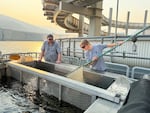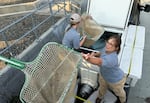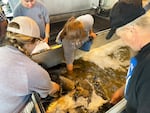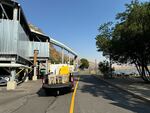
Darren Ogden, a biologist with NOAA, watches as technician Riley Krieg nets sockeye salmon to put them into a tank on a truck.
Courtney Flatt / NWPB
On the banks of the Snake River in far eastern Washington, sockeye salmon have had a rough summer. The water behind the last major concrete dam they have to swim past is way too hot.
“It’s running 74 degrees. That’s getting up to lethal temperatures for sockeye,” said David Venditti, a biologist with Idaho Fish and Game.
To keep the fish out of potentially deadly waters, this team is giving salmon some wheels. They’re hauling sockeye from Lower Granite Dam to the Eagle Creek Hatchery in central Idaho. The whole endeavor costs thousands of dollars.
At a holding pool, technicians scoop a fish at a time into a white tank on the back of a green pickup truck. Technician Tara Beckman stands in the truck bed. She dumps the salmon from the net into the tank.
“They are wily,” Beckman said, as the fish thrashed in the net.

Technicians Tara Beckman and Rebakah Windover help put salmon into a tank on the back of a pickup truck.
Courtney Flatt / NWPB
These fish need that energy to make their journey inland. Snake River sockeye are born in Idaho’s Sawtooth Mountains. The young salmon swim out to the ocean, where they live for up to three years.
When they’re ready to spawn, they make what sounds like an impossible journey.
“These salmon, they travel like 900 miles. It’s insane,” said Elizabeth Holdren, a supervisory biologist with the U.S. Army Corps of Engineers.
The salmon also climb roughly 6,500 feet in elevation until they reach the stream where they were born, Holdren said. Then, they spawn and die.
Related: Unchecked pollution is contaminating the salmon that Pacific Northwest tribes eat
This is the third summer biologists have trucked these endangered fish to cooler waters. The biologists first transported them in 2015, and then in 2021.
Scientists say it’s a peek into the future of a changing climate. Jay Hesse, with the Nez Perce Tribe, said less snowpack in the mountains means less water in Northwest rivers.
“Low stream flows result in elevated water temperatures because of reservoir habitats that tend to heat up faster and retain that heat,” Hesse said.
Climate change is one of the compounding problems for salmon, he said.

Technicians collect salmon and guide them into what’s known as a salmon sock.
Courtney Flatt / NWPB
David Johnson manages the fisheries department for the Nez Perce Tribe. He said many tribal members rely on salmon for their primary food, nutrition and livelihoods.
“Salmon and these tribes are hand-in-glove. Quite honestly, they’ve supported each other for countless years,” Johnson said.
Now, Snake River sockeye are on the brink of extinction, said Joseph Bogaard, the executive director of the fish advocacy group Save Our Wild Salmon. These salmon are some of the most endangered fish in the Northwest, he said.
“They’re giving us a message. Our ecosystems, our climate, our waters aren’t healthy. And they’re also telling us we’ve gotta do things differently and quickly or things are going to continue to unravel,” Bogaard said.
Trapping and hauling salmon for hundreds of miles is just a stopgap measure, he said.
“It’s really important right now. It is not a long-term strategy,” Bogaard said.

The juvenile fish bypass system at the Lower Granite Dam.
Courtney Flatt / NWPB
A long-term strategy to save salmon, he said, would be to breach the four dams on the lower Snake River.
However, the dams provide energy, transportation and irrigation for many communities across the region.
Some who rely on the dams say they aren’t the main reason the salmon aren’t doing well. They point to changing temperatures in the Pacific Ocean, the need for new culverts or better habitats to help salmon make it upstream.
Michelle Hennings, the executive director of the Washington Association of Wheat Growers, said there isn’t a silver bullet to protect these endangered fish.
“The dams aren’t one issue,” she said. “There are multiple issues that happen within why salmon could be at lower levels.”
Back at the Snake River, biologists add a few more fish to fill up the truck’s tank, and hop in the cab to start their drive.
“We’re taking fish from as early in the run as we can,” IDFG biologist Venditti said.

The Idaho Fish and Game truck drives off to transport sockeye around Lower Granite Dam and to cooler water in central Idaho.
Courtney Flatt / NWPB
To gather the sockeye, technicians gently guide fish into what’s called a salmon sock. The sock is a slender, blue bag and it’s about four feet long. It keeps the fish’s gills wet while a technician carries it to a tank on the back of a truck.
“You get an arm and a leg workout,” said Rebekah Windover, one of the technicians.
She plops the fish into the tank for its long ride to Idaho.
“They all look happy in there,” Beckman said, peering into the tank.
Related: The US has spent more than $2B on a plan to save salmon. The fish are vanishing anyway
The truck is packed with 800 pounds of ice split between several coolers. Keeping the fish cool between the occasional traffic jam or road work project are the biggest challenges for the team.
“It’s nerve-wracking. These aren’t just fish. It makes a long day even longer,” Venditti said.
This month, Venditti says they transported six truckloads of salmon. Although they’ve stopped trucking sockeye for the season, he said, temperatures in Washington are expected to creep back into the 100s Fahrenheit.